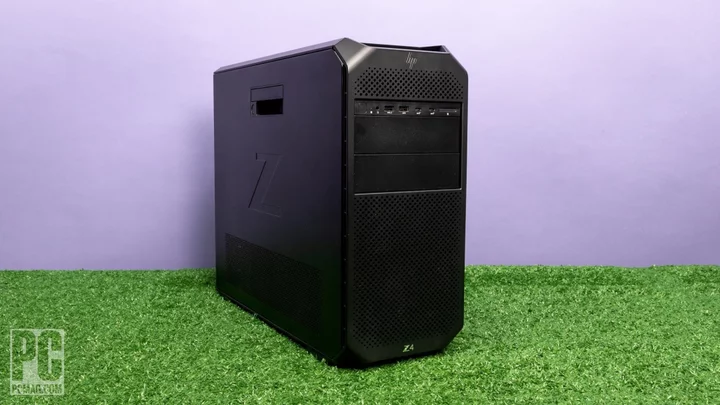The HP Z2 G9 desktop workstation packs a serious punch, but the Z4 G5 under review here (starts at $2,080; $6,691 as tested) takes that performance to the next level. Our kitted-out test sample has a 24-core Intel Xeon w7-2495X processor, which adds several thousand bucks to the price by itself, along with 64GB of error-correcting RAM, professional Nvidia graphics, and PCI Express 4.0 storage. It can also fit two high-end graphics cards and external NVMe bays. For getting things done, this is HP's ticket to the express train. The Z4 G5’s impressive capabilities earn it our Editors' Choice award among single-processor desktop workstations.
Big on Power, Not on Size
HP's Z4 G5 sits midway up its Z workstation lineup, which starts with the Z2 and goes beyond the Z4, the Z6, and Z8. The Z4 is the first tier that is considered a true workstation since it uses Intel's Xeon workstation processors, specifically the latest “Sapphire Rapids” Xeon w3 through w7 chips. These processors provide superior expansion to Intel's consumer "Core" chips, supporting 64 PCI Express lanes and 512GB of RAM.
Comparatively, the Z2 G9’s top choice, the Intel Core i9-13900K, tops out at just 20 lanes and only 128GB of RAM. Rest assured that the Z4 G5 won’t run out of bandwidth even with multiple graphics cards and storage drives. The main reason to step up to the Z6 or Z8 is if you need more than 24 processor cores or 512GB of RAM.
Unlike showy gaming desktops, the Z4 G5’s all-black exterior doesn’t drop many hints that it’s one of the most powerful towers available in this size. It sits squarely in the mid-tower territory, at 15.2 by 17.5 by 6.7 inches (HWD), being slightly longer and taller, but not wider, than the Z2 G9.
HP's Z4 case is mostly comprised of solid steel and feels built to last. I weighed our review unit at 27 pounds. The tower even has built-in carry handles, which are helpful for, if nothing else, safely getting it out of the shipping box.
The front panel has HP’s reflective logo along with the model name, the power button, and lots of airflow perforations. The premium port panel seen here has a universal audio jack, a USB-A 3.2 Gen 1 port (5Gbps), and two USB-C 3.2 Gen 2x2 ports (20Gbps). It looks like our unit has a full-size SD card reader, but it doesn’t—that’s optional. The standard panel loses the USB-C ports and sticks with four USB-A 3.2 Gen 1 ports.
For quick access to fast storage, the Z4 G5 will also come with optional hot-swappable NVMe front bays later in 2023, which is what those blank plastic panels are for. The bays can also be populated with optical drives or 3.5-inch drives.
The motherboard backplane has six USB-A 3.2 Gen 1 ports, Ethernet, and another universal audio jack. The cutout just above the Ethernet port is the optional flexible port option. This area can be configured with another USB-A, an additional USB-C port, or more networking options. The power supply is at the top of the tower; an auxiliary power button is just below it.
Our unit’s Nvidia RTX A4000 graphics card has four DisplayPort video outputs instead of the usual three DisplayPort and one HDMI port found on consumer cards. Its single-slot cooler leaves the other four expansion slots open, which include two PCI Express 4.0 x16 and two PCI Express 4.0 x4. The graphics card is connected to the PCI Express 5.0 x16 slot.
Opening the Z4 G5: A Technological Wonder
It’s always special looking inside a high-end workstation, and the Z4 G5 does a commendable job of displaying its latest technology. The tower's side panel tilts outward and away by pulling its release handle. The handle can be fitted with an optional Kensington lock slot, and you'll find a padlock loop at the back of the panel.
The 11-by-11-inch motherboard is based on the Intel W790 workstation chipset. The crown jewel here, though, is the Xeon w7-2495X 24-core processor, which has a 225-watt (W) base power and a 270W maximum turbo power. It’s a real challenge to keep from overheating, but the Z4 G5’s huge air cooler is up to the task. The Sapphire Rapids Xeon chips have a relatively massive physical footprint compared with Intel’s Core chips, which helps them dissipate the thermal load and makes air cooling practical. I don't notice significant noise from the Z4 G5 even when it is running under full load.
HP's plastic shroud over the CPU heatsink also covers the eight DDR5-4800 DIMM slots with active cooling. Removing the shroud is easily done by releasing two tabs. You won't have to disconnect any wires either: The shroud has a tiny power connector that plugs directly into the motherboard.
Our tower’s 64GB of RAM is made up of four 16GB sticks to take advantage of the Xeon w7’s quad memory channels. The bottom half of the motherboard has the mentioned PCI Express slots. Ahead of them are two M.2 2280 PCI Express 4.0 drive slots, both populated and covered with metal heatsinks. To their right, an intake fan behind the expansion card support brackets is well-positioned to provide airflow to the bottom half of the chassis. Two toolless 3.5-inch bays are just above it. For more storage, HP sells expansion cards with M.2 slots.
HP backs the Z4 G5 with a three-year warranty. Windows configurations with more than six cores require a rather pricey Windows 11 Pro for Workstations license. Included software is limited to HP’s apps, which include its Wolf Pro security suite. HP claims this tower also has hardware-level security. We don’t have a way of testing that, but it appears to have more resilience than you’d find in consumer hardware.
Testing the HP Z4 G5: 24 Cores on Tap
Our $6,691 Z4 G5 test unit has the fastest CPU available in this chassis, the 24-core/48-thread Xeon w7-2495X, which has a 2.5GHz base clock speed and a turbo boost up to 4.8GHz. It’s paired with 64GB of quad-channel DDR5-4800 error-correcting code (ECC) RAM, two 1TB PCI Express 4.0 storage drives (separate drives, no RAID), and an Nvidia RTX A4000 graphics card with 16GB of its own video RAM.
Pricing for our unit is the single-unit price. Businesses and enterprises buying this tower are likely to receive discounts for buying in bulk, so comparing prices of workstations isn’t really helpful.
In fact, our Z4 G5 configuration is only high-end in its CPU, at least as far as workstation hardware goes. HP will include up to 512GB of RAM, many more storage drives, and as many as two 48GB Nvidia RTX A6000 graphics cards. AMD Radeon Pro graphics cards are also available.
We pitted the Z4 G5 against other similarly equipped workstations for our comparison charts. The only recent entrant is the aforementioned HP Z2 G9, which has an RTX A4000 like our Z4 G5 but pairs it with an Intel Core i9-12900K. We also included the 64-core Lenovo ThinkStation P620. I've also included a few older models, like the Asus ProArt Station PD5 and the Dell Precision 3650. Both are entry-level mid-tower desktops that compare better with the Z2 G9 than our Z4 G5, but present some idea of the broader selection available.
Productivity and Content Creation Tests
Our first test is UL's PCMark 10, which simulates a variety of real-world productivity and office workflows to measure overall system performance and also includes a storage subtest for the primary drive. The Z4 G5 just about matched the ThinkStation P620, though it couldn’t catch the Z2 G9. It may seem surprising that a lower-tier workstation could perform better, but that’s not unusual in non-workstation-specific testing like this.
We use three more benchmarks, activating all available cores and threads, to rate a PC's suitability for processor-intensive workloads. Maxon's Cinebench R23 uses that company's Cinema 4D engine to render a complex scene, while Geekbench 5.4 Pro by Primate Labs simulates popular apps ranging from PDF rendering and speech recognition to machine learning. Finally, we use the open-source video transcoder HandBrake 1.4 to convert a 12-minute video clip from 4K to 1080p resolution (lower times are better).
Our final productivity test is PugetBench for Photoshop by Puget Systems, which uses the Creative Cloud version 22 of Adobe's famous image editor to rate a PC's performance for content creation and multimedia applications. It's an automated extension that executes a variety of general and GPU-accelerated Photoshop tasks ranging from opening, rotating, resizing, and saving an image to applying masks, gradient fills, and filters.
Now, we see the 24-core HP Z4 G5 make its mark. Its Xeon proved extremely potent in testing: Despite having fewer than half the ThinkStation’s 64 cores, it scored 57% as high in Cinebench. The other tests, especially HandBrake, don’t take full advantage of all CPU cores, so that’s the catch with mega-big core counts. The software you’re using must actually leverage all the cores to get your investment's worth.
Graphics Tests
Our graphics tests are next, and we won’t spend much time here since these aren’t typical workstation tasks. For Windows PCs, we run both synthetic and real-world gaming tests. The former includes two DirectX 12 gaming simulations from UL's 3DMark, Night Raid (more modest, suitable for systems with integrated graphics) and Time Spy (more demanding, suitable for gaming rigs with discrete GPUs). Also looped into that group is the cross-platform GPU benchmark GFXBench 5, which we use to gauge OpenGL graphics performance. Results are listed in frames per second (fps); higher numbers are better.
Both tests here are CPU-limited, but the Z4 G5’s numbers are in line with an Nvidia RTX A4000. Its performance fluctuated around the Asus model's Nvidia GeForce RTX 3070. But, again, you're not here for consumer-grade graphics performance, so let's move on.
Workstation Tests
We measure workstation graphics performance using SPECviewperf 2020, which renders, rotates, and zooms in and out of solid and wireframe models using view sets from popular independent software vendor (ISV) applications. We run the 1080p resolution tests based on PTC's Creo CAD platform; Autodesk's Maya modeling and simulation software for film, TV, and games; and the SolidWorks 3D rendering package by Dassault Systemes. Results here are also listed in frames per second (fps); higher numbers are better.
Not through yet with Adobe's creative suite, we also run PugetBench for Premiere Pro by Puget Systems, based on Adobe's popular video editing app. It performs live playback and file export with several codecs at 4K and 8K resolutions, as well as special-effects sequences that stress the CPU and GPU beyond normal Premiere Pro operations. We report the test's standard overall score.
Our last workstation test is Blender, an open-source 3D content creation suite for modeling, animation, simulation, and compositing. We record the time it takes for Blender's built-in Cycles path tracer to render two photo-realistic scenes of BMW cars, one using the system's CPU and one the GPU. Lower times are better. BMW artist Mike Pan has said he considers the scenes too fast for rigorous testing, but they're a popular benchmark.
The Z4 G5’s RTX A4000 made a fair showing in SPECviewperf, though the Z2 G9 (with the same GPU) beat it in two out of three tests. This may have been because the Z2’s Core i9 has higher clock speeds and can perform better in lightly-threaded tasks.
But the Z2 G9 couldn’t touch the Z4 G5 in Blender’s CPU test, where only the monster ThinkStation did better. The HP Z4 G5 also posted the highest Premiere Pro score.
On that note, remember that the Z4 G5 is configurable for many work tasks. Based on these results, it’s a hugely effective number-crunching or project rendering machine with the 24-core Xeon, but with room for two graphics cards, it can also support demanding machine learning and AI computing tasks. With additional bay options on the way, it’s also not shy in the storage department.
Verdict: The Ultimate Mid-Tower Workstation
Simply put, the HP Z4 G5 delivers on all fronts as a workstation. Like most high-end mid-tower workstations, its pricing puts it in "serious inquiries only" territory, but its powerful hardware can go a long way toward quickly recouping your investment. With six to 24 processor cores, up to 512GB of RAM, multiple NVMe storage drives, and capacity for two high-end professional graphics cards, tasks that this computer wouldn't be able to chew up are few and far between. We also noted its quiet operation, built-in security features, and three-year warranty. The Z4 G5 earns our Editors' Choice for single-processor workstations.









